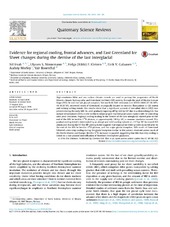| dc.contributor.author | Irvali, Nil | |
| dc.contributor.author | Ninnemann, Ulysses Silas | |
| dc.contributor.author | Kleiven, Helga Flesche | |
| dc.contributor.author | Galaasen, Eirik Vinje | |
| dc.contributor.author | Morley, Audrey | |
| dc.contributor.author | Rosenthal, Yair | |
| dc.date.accessioned | 2018-01-04T14:29:05Z | |
| dc.date.available | 2018-01-04T14:29:05Z | |
| dc.date.issued | 2016 | |
| dc.Published | Irvali N, Ninnemann US, Kleiven HF, Galaasen EV, Morley A, Rosenthal Y. Evidence for regional cooling, frontal advances, and East Greenland Ice Sheet changes during the demise of the last interglacial. Quaternary Science Reviews. 2016;150:184-199 | eng |
| dc.identifier.issn | 0277-3791 | en_US |
| dc.identifier.issn | 1873-457X | en_US |
| dc.identifier.uri | https://hdl.handle.net/1956/17130 | |
| dc.description.abstract | High-resolution lithic and sea surface climate records are used to portray the progression of North Atlantic climate, hydrography, and Greenland Ice Sheet (GIS) activity through the peak of Marine Isotope Stage (MIS) 5e into the last glacial inception. We use Eirik Drift sediment core MD03-2664 (57°26.34′N, 48°36.35′W), recovered south of Greenland, strategically located to monitor fluctuations in GIS extent and iceberg calving events. Our results show that a significant amount of ice-rafted debris (IRD) was present during the early MIS 5e, until gradually tapering off by 122 kyr BP due to a diminishing GIS. Sea surface temperatures (SSTs) in the northern subpolar gyre reached peak values early in MIS 5e coinciding with peak insolation. Regional cooling leading to the demise of the last interglacial started prior to the end of the MIS 5e benthic δ18O plateau, at approximately 119 kyr BP, as summer insolation waned. This gradual cooling trend is interrupted by an abrupt and brief cooling episode at ∼117 kyr BP. Increased IRD abundance during the 117 kyr BP cooling event suggests that regional ice sheet growth occurred prior to the end of the MIS 5e benthic δ18O plateau, and the major glacial inception. SSTs south of Greenland followed a two-step cooling during the glacial inception similar to the pattern observed across much of the North Atlantic and Europe. Benthic δ18O increases in parallel, suggesting that this two-step cooling is linked to a two-phased intensification of Northern Hemisphere glaciation. | en_US |
| dc.language.iso | eng | eng |
| dc.publisher | Elsevier | en_US |
| dc.rights | Attribution-NonCommercial-NoDerivatives CC BY-NC-ND | eng |
| dc.rights.uri | http://creativecommons.org/licenses/by-nc-nd/4.0/ | eng |
| dc.subject | Eirik drift | eng |
| dc.subject | Greenland Ice Sheet | eng |
| dc.subject | North Atlantic | eng |
| dc.subject | Last interglacial | eng |
| dc.subject | Glacial inception | eng |
| dc.subject | Multi-proxy | eng |
| dc.title | Evidence for regional cooling, frontal advances, and East Greenland Ice Sheet changes during the demise of the last interglacial | en_US |
| dc.type | Peer reviewed | |
| dc.type | Journal article | |
| dc.date.updated | 2017-12-05T12:17:45Z | |
| dc.description.version | publishedVersion | en_US |
| dc.rights.holder | Copyright 2016 The Authors | en_US |
| dc.identifier.doi | https://doi.org/10.1016/j.quascirev.2016.08.029 | |
| dc.identifier.cristin | 1376470 | |
| dc.source.journal | Quaternary Science Reviews | |

